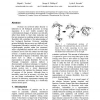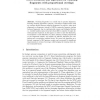2877 search results - page 151 / 576 » Biological Computing |
73
Voted
RECOMB
2002
Springer
15 years 10 months ago
2002
Springer
Proteins are involved either directly or indirectly in all biological processes in living organisms. It is now widely accepted that conformational changes of proteins can critical...
AHS
2007
IEEE
15 years 4 months ago
2007
IEEE
In this paper, key features of biological vs. artificial systems are identified, along with a synopsis of important consequences of those features. An artificial substrate that co...
NGC
2002
Springer
14 years 9 months ago
2002
Springer
In the attempt to have a framework where the computation is done by communication only, we consider the biological phenomenon of trans-membrane transport of couples of chemicals (o...
ICTAC
2004
Springer
15 years 3 months ago
2004
Springer
Abstract. P systems (known also as membrane systems) are biologically motivated theoretical models of distributed and parallel computing. The two most interesting questions in the ...
RECOMB
2010
Springer
14 years 8 months ago
2010
Springer
Chaining fragments is a crucial step in genome alignment. Existing chaining algorithms compute a maximum weighted chain with no overlaps allowed between adjacent fragments. In prac...


